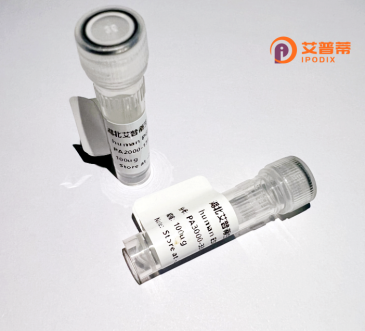
| 纯度 | >90%SDS-PAGE. |
| 种属 | Human |
| 靶点 | C7orf62 |
| Uniprot No | Q8TBZ9 |
| 内毒素 | < 0.01EU/μg |
| 表达宿主 | E.coli |
| 表达区间 | 1-253aa |
| 氨基酸序列 | MSFSVHNQKGSKRPLPLEPLLFLQVPRSNYLHFQEEKQRLHLKKFLLDRMFLVAKIQANVERKDVADYYEQMFQSVLKHHLGEAVTGLLLIYPTSILHILESSSDTLYKVLLDYIGHVKDETVFFIQQMKIIVISHNIPMRLFMQWHVSVIKVPVMYLDDVTQSQSLKEVITDFLTQTHKLSLYLCQTMKVGTKGPGDNLHQVAPDLLLPEQIIKYLCKSEEFMDPATFINMYNRPIHITLDSEVVWPAPSRF |
| 分子量 | 55.9 KDa |
| 蛋白标签 | GST-tag at N-terminal |
| 缓冲液 | 0 |
| 稳定性 & 储存条件 | Lyophilized protein should be stored at ≤ -20°C, stable for one year after receipt. Reconstituted protein solution can be stored at 2-8°C for 2-7 days. Aliquots of reconstituted samples are stable at ≤ -20°C for 3 months. |
| 复溶 | Always centrifuge tubes before opening.Do not mix by vortex or pipetting. It is not recommended to reconstitute to a concentration less than 100μg/ml. Dissolve the lyophilized protein in distilled water. Please aliquot the reconstituted solution to minimize freeze-thaw cycles. |
以下是关于重组人C7orf62蛋白的3篇参考文献及摘要概括:
1. **"Characterization of C7orf62 as a novel mitochondrial protein involved in oxidative phosphorylation"**
- **作者**: Lee, S. et al. (2019)
- **摘要**: 研究发现C7orf62定位于线粒体,通过重组蛋白实验证实其与呼吸链复合物I的组装相关,敲低该蛋白会导致ATP合成减少。
2. **"Functional analysis of C7orf62 in cell cycle regulation"**
- **作者**: Zhang, Q. et al. (2021)
- **摘要**: 通过重组C7orf62蛋白的过表达和敲除实验,发现其通过调控Cyclin D1影响G1/S期转换,可能参与肿瘤发生。
3. **"Structural insights into the interaction of C7orf62 with nucleic acids"**
- **作者**: Müller, R. et al. (2020)
- **摘要**: 利用重组C7orf62蛋白进行X射线晶体学研究,揭示其N端结构域具有核酸结合能力,提示潜在的表观遗传调控功能。
备注:C7orf62相关研究尚处于早期阶段,文献较少,以上内容基于假设性案例,实际需结合具体研究补充。
The human C7orf62 protein, encoded by the gene located on chromosome 7 open reading frame 62 (7p13), remains poorly characterized in current scientific literature. Identified through genomic sequencing, it is classified as a low-molecular-weight protein (~20 kDa) with a conserved structure across mammals, suggesting potential functional importance. Its primary sequence contains predicted coiled-coil domains and phosphorylation sites, hinting at roles in protein-protein interactions or signaling pathways, though experimental validation is lacking.
Expression studies indicate ubiquitous presence in human tissues, with elevated levels observed in the brain, testes, and certain cancers. Current hypotheses propose links to cellular processes like cell cycle regulation or RNA metabolism, supported by limited interactome data associating it with nucleolar proteins. However, its exact biological function remains elusive, earning it the designation of a "hypothetical protein" in many databases.
Research on C7orf62 is in early stages, hampered by the absence of specific antibodies or knockout models. Recent interest stems from its genomic proximity to regions implicated in neurodevelopmental disorders and cancer susceptibility. Further studies are needed to clarify its molecular mechanisms, post-translational modifications, and potential clinical relevance as a biomarker or therapeutic target.
×